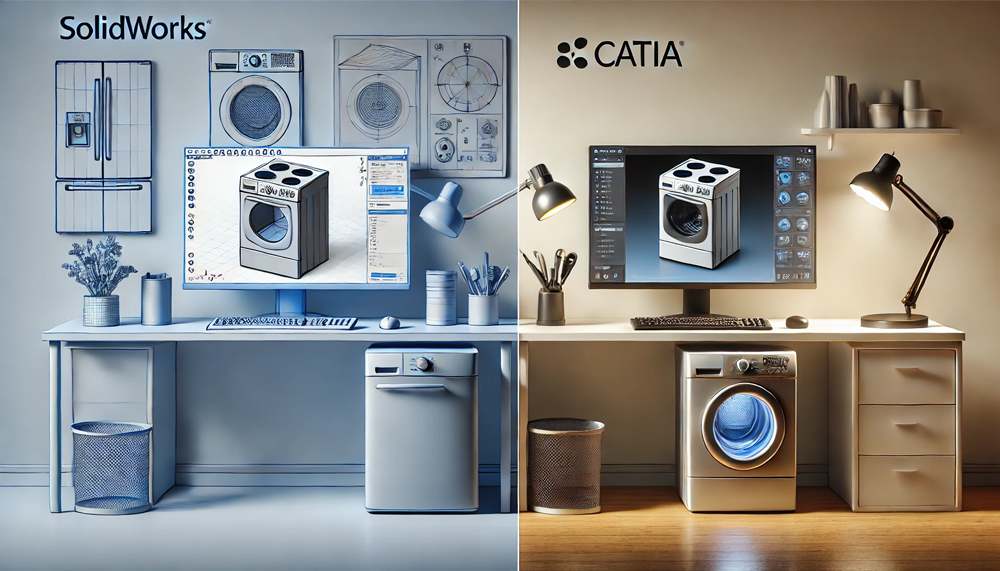
Introduction: SolidWorks vs CATIA for Appliance Design
Designing appliances requires powerful tools to create models, test ideas, and bring innovative products to life. SolidWorks and CATIA are two of the most popular software programs used for this purpose. While both programs offer advanced features for 3D modeling and product design, they serve different types of users and projects. SolidWorks is known for its simplicity and quick prototyping, making it a popular choice for smaller appliance designs. On the other hand, CATIA provides complex engineering tools, often preferred for detailed and large-scale projects.
In this article, we’ll compare SolidWorks and CATIA for appliance design, exploring their unique features, advantages, and which software might best fit your needs.
SolidWorks vs CATIA: Which Is Better for Appliance Design?
When designing home appliances, using the right software is essential. Two popular tools for this work are SolidWorks and CATIA. But how do they compare, and which is better for creating appliances?
SolidWorks is a great choice for users who need easy tools and fast modeling. It is user-friendly and has many features that make it simple to design 3D models quickly. Many small and medium businesses use SolidWorks because it is effective and affordable.
CATIA, on the other hand, is used by big companies, like those in the automotive and aerospace industries. This software has advanced tools, making it ideal for complex designs. For appliance design, CATIA can offer more detail, but it might be harder to learn and is usually more expensive.
So, if you are starting and need a simpler tool, SolidWorks could be the better choice. If you work with very complex designs and need extra features, CATIA might be the right software for you. Choosing between SolidWorks and CATIA for appliance design depends on your project needs and budget.

Key Differences Between SolidWorks and CATIA in Home Appliance Design
Understanding the main differences between SolidWorks and CATIA can help you choose the best software for home appliance design. Each program has unique features that make it suitable for different types of projects.
1. Ease of Use: SolidWorks is known for being simple and easy to learn, especially for beginners. Its user-friendly interface allows users to start designing quickly. CATIA, however, has a more complex interface and requires training to use effectively. This complexity makes it better suited for professional designers who work on complex projects.
2. Design Complexity: SolidWorks works well for simpler appliance designs and smaller projects. It’s ideal for quick 3D modeling and creating parts that aren’t too intricate. CATIA, on the other hand, excels in handling large, complex designs. It offers advanced tools that allow users to work on detailed models, which can be useful when creating high-tech appliances.
3. Cost: For many, cost is an important factor. SolidWorks is generally more affordable, which makes it a popular choice for smaller businesses and startups. CATIA, though, is more expensive but provides powerful features, which are valuable for advanced engineering projects.
These are the key differences between SolidWorks and CATIA for appliance design. If you need a quick, easy-to-use tool, SolidWorks might be the best choice. If you’re working on complex designs and need advanced features, CATIA could be worth the investment.

How to Choose Between SolidWorks and CATIA for Designing Appliances
Choosing the right software, whether SolidWorks or CATIA, for appliance design can make a big difference in your project’s success. Here are some simple tips to help you decide.
1. Consider Your Project Complexity: If your appliance design is straightforward and doesn’t require many complex details, SolidWorks may be perfect. It’s easy to use, which means you can start creating 3D models quickly. If your project is more complicated and needs highly detailed parts, CATIA might be a better choice.
2. Think About Your Budget: SolidWorks is usually more budget-friendly. If you’re a small business or just starting in appliance design, this can be a major advantage. CATIA is more expensive but provides advanced tools that might be worth it if your work demands high precision.
3. Look at Your Future Needs: If you plan to work on larger or more complex projects in the future, learning CATIA could be beneficial. It’s commonly used by professionals in industries that require detailed design, like automotive and aerospace. However, if your focus remains on simpler appliance designs, SolidWorks will likely meet your needs.
By evaluating your project’s complexity, budget, and future needs, you can choose the best software for your appliance design projects.
SolidWorks or CATIA: The Best Software for 3D Appliance Modeling
When it comes to creating 3D models for appliances, both SolidWorks and CATIA are powerful options. Let’s look at why each software is useful for 3D appliance modeling.
1. SolidWorks for Quick Modeling: SolidWorks is ideal for fast, efficient 3D modeling. Its tools are easy to learn, making it great for designers who want to create appliance models quickly. SolidWorks also offers many customization options, so users can adjust the features to fit their design needs.
2. CATIA for Advanced Modeling: If you’re working on a very detailed or technical appliance design, CATIA might be the better option. CATIA’s powerful tools allow for intricate modeling and support for larger projects. This software is often used in complex industries and can handle advanced engineering needs, which is helpful when designing complex appliance components.
3. Design Accuracy and Detail: CATIA is known for its accuracy, making it ideal for designs that need exact specifications and high-quality details. SolidWorks, while also precise, is generally used for simpler designs that don’t require such high complexity.
In summary, for quick and straightforward 3D modeling, SolidWorks may be the best choice. If your appliance designs require advanced features and high detail, CATIA could be a better fit.
Advantages of Using SolidWorks and CATIA in Appliance Manufacturing
Both **SolidWorks** and **CATIA** bring unique advantages to appliance manufacturing. Here’s a look at how each software can benefit the design and production process.
1. SolidWorks: Easy Prototyping and Design Adjustments
SolidWorks is excellent for creating prototypes and making quick adjustments to designs. Its simple interface allows designers to test different ideas and make changes fast. This helps save time and can reduce costs, especially for small to medium-sized manufacturing projects.
2. CATIA: Advanced Engineering and Detailed Simulations
For appliance manufacturers that require advanced engineering and high levels of detail, CATIA is highly valuable. CATIA offers simulation tools that allow designers to test how appliances will perform in real-world conditions, which can help identify and solve design issues before production.
3. Collaboration and Integration
SolidWorks and CATIA both offer options for team collaboration, allowing designers, engineers, and manufacturers to work together effectively. SolidWorks is more commonly used in smaller teams and offers tools that are easy to share. CATIA, designed for large projects, has advanced collaboration features that make it ideal for big manufacturing environments.
In conclusion, SolidWorks is great for fast prototyping and simple adjustments, while CATIA provides advanced tools for detailed engineering and simulations. Each can enhance the appliance manufacturing process in its own way.
SolidWorks vs CATIA: Pros and Cons for Appliance Product Designers
When it comes to appliance design, both SolidWorks and CATIA have their strengths and weaknesses. Here’s a quick look at the pros and cons of each software to help appliance product designers decide.
Pros of SolidWorks:
– User-Friendly Interface: SolidWorks is easy to learn, especially for beginners, making it a good choice for designers who want a straightforward design experience.
– Cost-Effective: It is generally more affordable than CATIA, making it accessible for small businesses and startups.
– Quick Prototyping: Ideal for fast and efficient prototyping, SolidWorks allows for quick design modifications, which can save time and resources.
Cons of SolidWorks:
– Limited Advanced Features: SolidWorks may not have the complex tools needed for high-detail or technical appliance designs.
– Not Ideal for Large-Scale Projects: For very large or intricate projects, SolidWorks may not provide the flexibility or depth that some designers need.
Pros of CATIA:
– Advanced Design and Engineering Tools: CATIA is equipped with high-level tools for detailed and complex designs, making it suitable for precision engineering in appliance design.
– Great for Collaboration: CATIA’s features make it easy for large teams to work together on extensive projects, which can improve design accuracy and consistency.
– Accurate Simulations: The simulation tools in CATIA allow designers to test and optimize designs before production, helping to catch errors early.
Cons of CATIA:
– Higher Cost: CATIA is more expensive, which may make it less accessible for smaller teams or individuals.
– Steeper Learning Curve: Due to its advanced tools and features, CATIA requires more training and experience to use effectively.
In summary, SolidWorks is user-friendly and cost-effective, ideal for smaller projects, while CATIA offers advanced tools and accuracy, better suited for complex and large-scale appliance designs.
Conclusion: Choosing Between SolidWorks and CATIA for Appliance Design
Both SolidWorks and CATIA are powerful tools for appliance design, but each has its own strengths. SolidWorks stands out for its user-friendly interface, affordability, and suitability for quick prototyping and simpler designs. This makes it an excellent choice for small to medium-sized projects or businesses with limited budgets. CATIA, in contrast, excels with its advanced engineering tools, detailed simulations, and capabilities for handling complex, large-scale designs. It’s ideal for teams working on intricate projects that require precision and collaborative workflows.
Ultimately, choosing between SolidWorks and CATIA for appliance design depends on your project’s complexity, budget, and long-term goals. By aligning your choice with these factors, you can select the best software to support innovative and efficient appliance designs.










